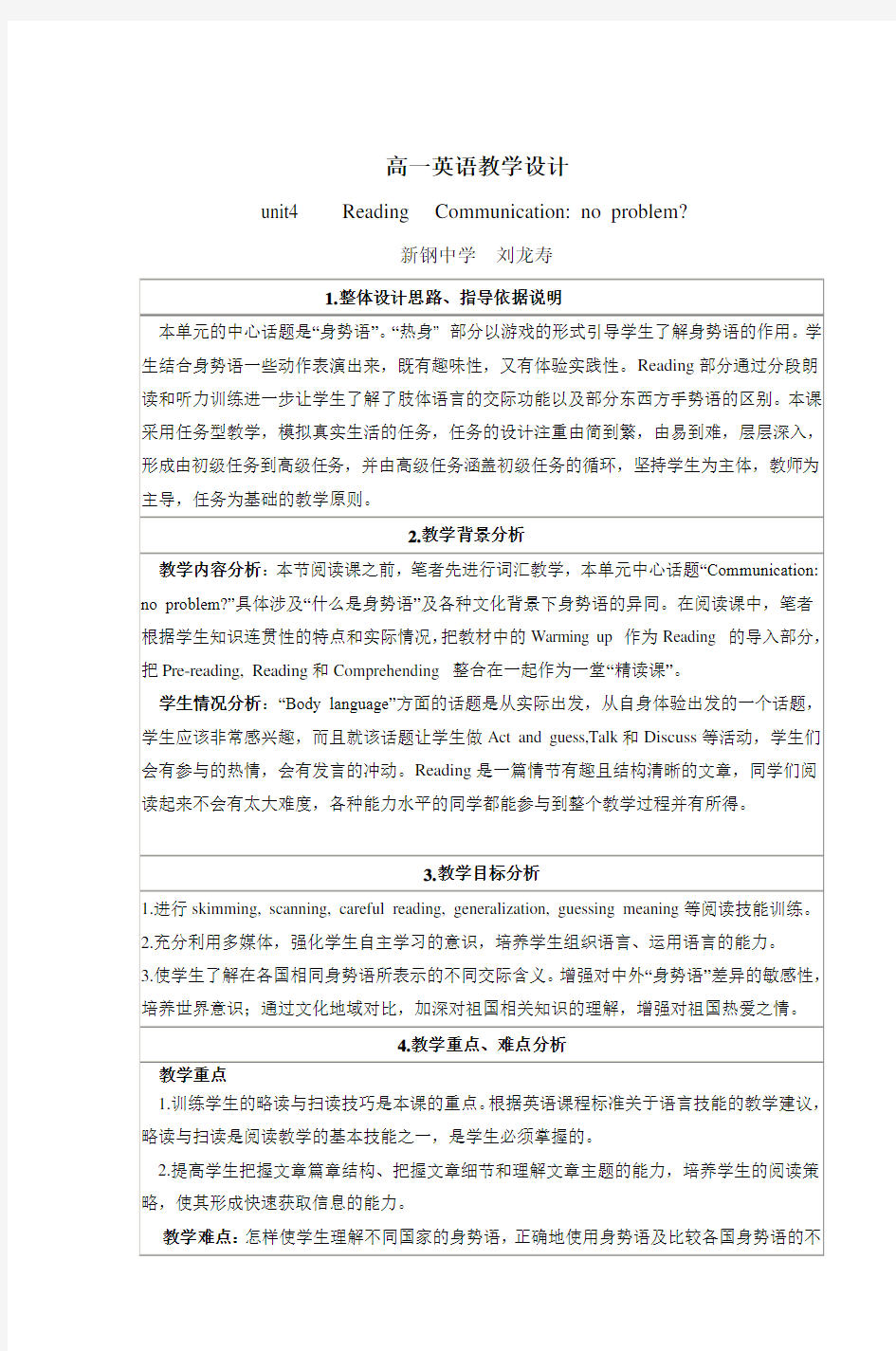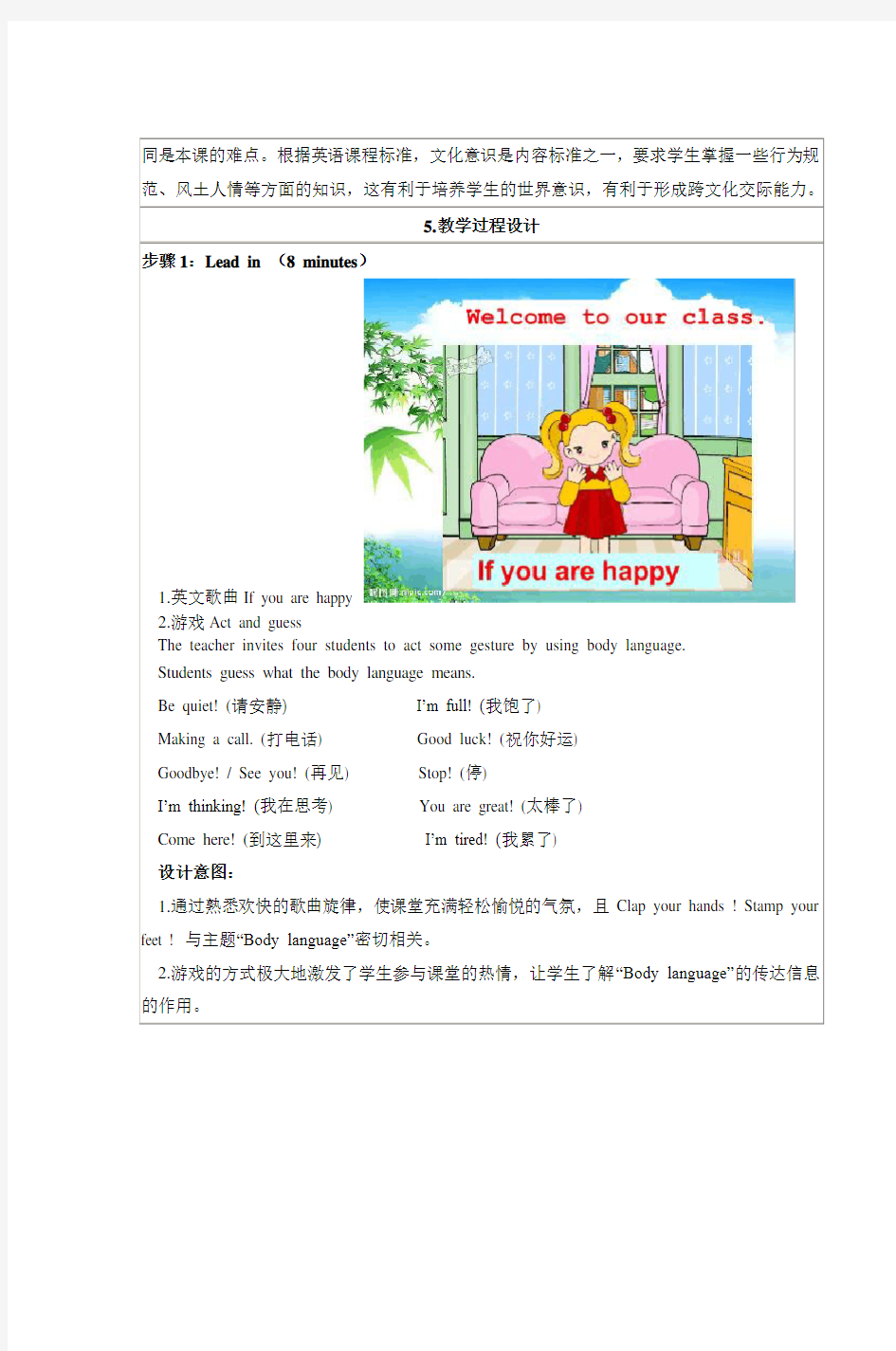高一英语教学设计方案


高一英语教学设计
unit4 Reading Communication: no problem?
新钢中学刘龙寿
同是本课的难点。根据英语课程标准,文化意识是内容标准之一,要求学生掌握一些行为规范、风土人情等方面的知识,这有利于培养学生的世界意识,有利于形成跨文化交际能力。
5.教学过程设计
步骤1:Lead in(8 minutes)
1.英文歌曲If you are happy
2.游戏Act and guess
The teacher invites four students to act some gesture by using body language.
Students guess what the body language means.
Be quiet! (请安静) I’m full! (我饱了)
Making a call. (打电话) Good luck! (祝你好运)
Goodbye! / See you! (再见) Stop! (停)
I’m thinking! (我在思考) You are great! (太棒了)
Come here! (到这里来) I’m tired! (我累了)
设计意图:
1.通过熟悉欢快的歌曲旋律,使课堂充满轻松愉悦的气氛,且Clap your hands ! Stamp your feet ! 与主题“Body language”密切相关。
2.游戏的方式极大地激发了学生参与课堂的热情,让学生了解“Body language”的传达信息的作用。
步骤2:Reading(30 minutes)
1.Fast reading(8 minutes)
Which is the main idea of the text?
A. There are different customs in different countries.
B. Foreigners should follow the customs of the country where they are visiting.
C. People use body language to send messages and different body language has different meanings.
D. The importance of knowing customs.
How many parts can this passage be divided into?
Try to find out the main idea of each part.
Part 1(Para.1) I went to the airport to meet the international student.
Part 2 (Para.2-4) People from different countries have different body language.
Part 3 (Para.5) Summary of body language.
设计意图:通过让学生找出文章主题和划分段落的练习,使学生获取文章大意,培养快速阅读能力,养成整体阅读的习惯,关注语篇内容和结构。略读是学生应掌握的一项基本的阅读能力,通过略读可以把握文章大意。在完成阅读任务前,老师可给予学生一些阅读技巧方面的指导,如略读(skimming)文章标题、小标题以及每个段落第一行,关注文章中反复出现的关键词等。通过不断掌握阅读技巧,学生快速获取文章信息的能力及阅读速度也会不断提高。
《英语课程标准》“语言技能目标(七级)”要求“能理解文章主旨”。文章大意是阅读理解题型必考的题型,部分学生可能会选第一项A,应让学生明白主旨大意是以全文角度出发,而不是局部内容。
2.Careful reading(22 minutes)
①分段朗读和听力训练
Para.1(3 minutes)Fill in the blanks.
Time: yesterday
People: another student and I ,this year’s international students
Place: the Capital International Airport
What to do: We would take them first to their dormitories and then to the student canteen. Para2(9 minutes)Retell the two cultural mistakes after listening to the tape and watching
a video.
②复述情景Students retell the two cultural mistakes,attention to the sentence: “She stepped back, appearing surprised and put up her hands, as i f in defence.”(The –ing form is used as Adverbial).
Presents some sentences with –ing form of verb as attribute or adverbial, e.g.
?They are visitors coming from several countries. (Paraphrase it by using attributive clause)
?Four people enter looking around in a curious way. (Divide it into two sentences) …
Students: Rewrite sentences.
Para3(3 minutes)
1. How do men from Muslim countries greet others?
To man: stand close, and shake hands
To women: nodding
2. How did Tony and Darlene greet each other?
They shook hands and kissed each other on each cheek, since that is the French custom when adults meet people they know.
Para4(3 minutes)fill in the chart.
Para5(2 minutes)
Which way of greeting is the best: kissing, smiling, handshaking or bowing?
These actions are not good or bad, but are simply ways in which cultures have developed. When in Rome, do as the Romans do.
③判断正误(2 minutes)
1. English often stand close to others or touch strangers as soon as they meet. (F)
2. All members of a culture behave in the same way. (F)
3. Learning English well can certainly help avoid difficulties in today’s world of cultural crossroads. (T)
4. Japanese will bow to others as greeting. (T)
5. Body language in some countries is good while some in others is bad. (F)
设计意图:
(1) 学生分段朗读和听力训练:让学生分小组朗读课文段落,可以使学生都参与到课堂中,朗读之后,再来听课文录音,同学们可以模仿录音的语音语调,纠正他们的发音。
(2) 观看同学在录相中表演的两个cultural mistakes后,再重述情景,能锻炼他们的英语口头表达能力,同时讲解重要知识点,进一步领悟现在分词作状语和定语的用法。
(3) 通过细读的方式阅读课文,有利于学生理解文中具体细节。根据课文中每个段落的重要内容,设置难度适中的True or False 问题,让学生通过抢答的方式解决问题,能充分调动全体学生参与课堂教学的热情,要求学生做练习时找出其判断的依据,培养学生良好的阅读习惯。
步骤3:Discussion(5 minutes)
Do you think body language is important? Can you give some examples in our daily life? Allow students a few moments to discuss in groups of four. The teacher offers help to those who have difficulty, ask two students to come to the blackboard and write down opinions of other students.
设计意图:引导学生讨论身体语言在日常生活中的运用,让两位同学将其他同学说提的观点呈现在黑板上,把课文阅读与听说写有机地整合起来,激发学生的发散性思维能力。
步骤4:Summary(2 minutes)
